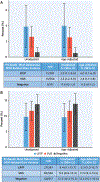Screening for Dilated Cardiomyopathy in At-Risk First-Degree Relatives
- PMID: 37225358
- PMCID: PMC10563038
- DOI: 10.1016/j.jacc.2023.03.419
Screening for Dilated Cardiomyopathy in At-Risk First-Degree Relatives
Abstract
Background: Cardiovascular screening is recommended for first-degree relatives (FDRs) of patients with dilated cardiomyopathy (DCM), but the yield of FDR screening is uncertain for DCM patients without known familial DCM, for non-White FDRs, or for DCM partial phenotypes of left ventricular enlargement (LVE) or left ventricular systolic dysfunction (LVSD).
Objectives: This study examined the yield of clinical screening among reportedly unaffected FDRs of DCM patients.
Methods: Adult FDRs of DCM patients at 25 sites completed screening echocardiograms and ECGs. Mixed models accounting for site heterogeneity and intrafamilial correlation were used to compare screen-based percentages of DCM, LVSD, or LVE by FDR demographics, cardiovascular risk factors, and proband genetics results.
Results: A total of 1,365 FDRs were included, with a mean age of 44.8 ± 16.9 years, 27.5% non-Hispanic Black, 9.8% Hispanic, and 61.7% women. Among screened FDRs, 14.1% had new diagnoses of DCM (2.1%), LVSD (3.6%), or LVE (8.4%). The percentage of FDRs with new diagnoses was higher for those aged 45 to 64 years than 18 to 44 years. The age-adjusted percentage of any finding was higher among FDRs with hypertension and obesity but did not differ statistically by race and ethnicity (16.2% for Hispanic, 15.2% for non-Hispanic Black, and 13.1% for non-Hispanic White) or sex (14.6% for women and 12.8% for men). FDRs whose probands carried clinically reportable variants were more likely to be identified with DCM.
Conclusions: Cardiovascular screening identified new DCM-related findings among 1 in 7 reportedly unaffected FDRs regardless of race and ethnicity, underscoring the value of clinical screening in all FDRs.
Keywords: dilated cardiomyopathy; family members; screening.
Copyright © 2023 American College of Cardiology Foundation. Published by Elsevier Inc. All rights reserved.
Conflict of interest statement
Funding Support and Author Disclosures Research reported in this publication was supported by a parent award from the National Heart, Lung, and Blood Institute of the National Institutes of Health under Award Number R01HL128857, which included a supplement from the National Human Genome Research Institute. The DCM Precision Medicine Study was supported by computational infrastructure provided by The Ohio State University Division of Human Genetics Data Management Platform and the Ohio Supercomputer Center. The authors have reported that they have no relationships relevant to the contents of this paper to disclose.
Figures




Comment in
-
Clinical Screening for Dilated Cardiomyopathy in At-Risk First-Degree Relatives: Who, When, and How?J Am Coll Cardiol. 2023 May 30;81(21):2072-2074. doi: 10.1016/j.jacc.2023.04.001. J Am Coll Cardiol. 2023. PMID: 37225359 No abstract available.
References
-
- Heidenreich PA, Bozkurt B, Aguilar D, et al. 2022 AHA/ACC/HFSA guideline for the management of heart failure: a report of the American College of Cardiology/American Heart Association Joint Committee on Clinical Practice Guidelines. J Am Coll Cardiol. 2022;79(17):e263–e421. 10.1016/j.jacc.2021.12.012 - DOI - PubMed

